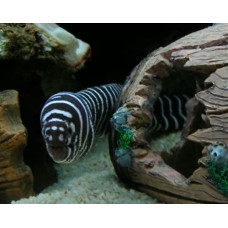Latin name
Gymnomuraena zebra
Other names
Gymnomuraena zebra
Identification
The snout is round and short. Vertebrae: 132-137. Have closely set teeth used to crush prey with hard shells.
Features of fish fins
Dorsal spines (total): 0; Dorsal soft rays (total): 0; Anal spines: 0; Anal soft rays: 0.
Fish colouring
The fish are densely fringed with dark and whitish stripes, giving them their common name.
Distribution
Widespread throughout the Indo-Pacific region from the east coast of Africa to the west coast of the Americas, including the Red Sea, Hawaii, and the Galapagos Islands.
Habitat
Tropical marine bottom fish, preferred habitat is rocky or coral reefs in shallow coastal waters down to 40 meters.
Size
Considered a medium sized fish, they can reach a maximum length of 150 cm. Usually the observed average size is around 50 cm.
Behavior
They are nocturnal and actively hunt their prey. Hidden inhabitants of sandy and rocky bottoms, crevices and ledges of coastal reefs.
Food and feeding habits
Unlike most other morays, they feed exclusively on crustaceans, sea urchins and mollusks.
Reproduction
Possibly a protogenic hermaphrodite. Primogeniture is not confirmed.
Fishing
They have little commercial value. Fished for sale to aquariums.
Relationship with a person
A species of fish that is harmless to humans.
| Classification | |
| Phylum | Chordata |
| Class | Actinopterygii |
| Squad | Anguilliformes |
| Family | Muraenidae |
| Genus | Gymnomuraena |
| Species | G. zebra |
| Features | |
| Conservation status | Least Concern |
| Habitat | Bottom |
| Life span, years | No information |
| Maximum body weight, kg | No information |
| Maximum length, cm | 150 |
| Sailing speed, m/s | No information |
| Threat to people | Not edible |
| Way of eating | Predator |
Zebra moray
Tags: zebra moray



